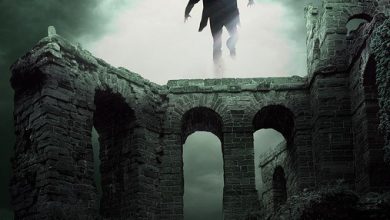The Falling Girl, a short story written by the Italian author, Dino Buzzati, focuses on the tragedy that befalls 19-year-old Marta. A close-knit, third-person narrative recounting the tale of dreams of a fantastical life being crushed, The Falling Girl, explores the themes of discrimination, social inequality, class differences, and the struggle to cope and adjust to the world of capitalist society.
The Falling Girl — Summary
The short story begins at the time of dusk with the introduction of the protagonist, Marta, standing on top of the skyscraper and looking over its roof. She is completely swept away by the beauty of the city, shimmering under the beautiful sunset during the evening hour. At once Marta, “hopelessly” lets go of herself and falls from the skyscraper. As she keeps falling, she narrates to us all the things that she witnesses. There were “rich and elegant people” enjoying themselves with sips of cocktails and “silly conversations”. There were also “millionaires’ balconies” whose “gallant” hands were all ready to be given to Marta, an offer or invitation to come and have fun with them.
In between her falling, the narrator informs the readers that, flights from these skyscrapers have become an “interesting diversion for the tenants” and as a result, the prices for these apartments have soared high. Marta continues to fall but all the while feeling fascinated, interesting, and stylish. Although she wonders if her “simple clothing” was prominent to the rich world, she feels happy that the sun has not yet set and is successfully illuminating her dress to make it look “chic”. As the sun gets absorbed into the sea, Marta notices another girl falling right above her, and then more and more women are falling off from the sides of the skyscraper. But she noticed the difference between her and the rest of the women falling. They were all more pretty and fancily dressed than Marta. At this moment, she starts feeling betrayed by the “cruel power” of the “pinnacle” of the skyscraper that inspired her to fall off. Sadly, Marta says that she won’t be able to make it on time for the ball or the party happening because the sun has already set and the darkness is covering the world.
As the dawn spreads and morning rises, we read the conversation between a couple as the woman catches a glimpse of Marta as she passes off the window of their rooms. As the man named Alberto, inquires his wife, unbothered, she responds that she saw a “decrepit old woman” passing by. Alberto disinterestedly mutters that on these low floors, they only get to see old and haggard women, unlike on the top floors they get to see beautiful girls. But the wife points out to her husband the advantage of living on these low floors, wherein they get to hear the sound of the thud, the falling off the woman as she reaches the ground. However, we never hear any sound of Marta’s body hitting the ground.
The Falling Girl — Analysis
Buzzati brilliantly knits together the short story to give insight into the world of indifferences through the use of surreal dream-like images, eliminating any logic. Such a skillful technique of employing a surreal world of narration ensures Buzzati’s short story to not read as any pure tragical short story.
At the beginning of the story, we see Marta adoring the evening hour that enlivens the city life; a clear connotation of her desire to be part of the city. The writer acutely portrays the capitalist city engaged in fanciful activities to show the readers where Marta is being differentiated and placed. The differences are clearly shown by highlighting the city life:
“Within it were powerful men, and women who were even more powerful, furs and violins, cars glossy as onyx, the neon signs of nightclubs, the entrance halls of darkened mansions, fountains, diamonds, old silent gardens, parties, desires, affairs..”.
Although at first, Marta feels slightly dizzy from looking down to the city beneath from the skyscraper, she begins to fetishize it. Even the skyscraper was “silver, supreme and fortunate” in that golden hour. The narrator describes the time before the sunset as “the hour when the city is seized by inspiration”. Here in the story, Marta is inspired by the deceptive images of the city that the beautiful evening shows her.
Mesmerized or simply hypnotized by the beauty of all the things that she sees from the skyscraper, her desire to fall into these lives is also heightened. In a moment, Marta falls, shocking the readers. From here on, the author brilliantly suspends the readers in the air of mystery similar to Marta continuously falling from the air. Moreover, herein we enter the bizarre world of narration where the plot line is devoid of any logic. In other words, we simply enter the world of dreams, a fantastical life visioned by Marta that was “provoked” by the “sorcery of the evening”, as described in the short story.
Several moments in the short story give insight to the readers on Marta’s wish to be a part of the hustling, bustling, and fanciful city but at the same time, the writer invokes the presence of conflict or simply an existential crisis following Marta. All the while falling, she becomes concerned about her simple and modest way of dressing that might give away her class difference from the people living in the huge buildings of the city. Such a conflict is highlighted in depth when she says that the “lyrical light” of the sun is making her modest dress way, to look “chic”. In addition to this, the narration makes us wonder about the absurdity lying beneath the fact that Marta’s imagination goes as such, “the beautiful people, then, were interested in her and that filled her with satisfaction. She felt fascinating, stylish”.
The complete elimination of any emotional tone, as Marta falls, might suggest the writer’s cunning way of allowing the people to think about the reality and truth within a capitalist world. The simple truth is that people don’t have any time to bother about another person because they have become too immersed in the capital, technological world. In other words, only something big and significant as falling off a building can make people look up. Unfortunately, Marta is too naive to know this truth and as a result, her dream to rush through her hopeless life to enter a life of opportunity that embodies “fate” and “romance” and as Marta calls such a moment, “the true inauguration of her life”, remains until she realizes that even falling is a competition, some kind of contest.
Fear creeps inside Marta as she sees other women as well, who are fancy and very well dressed, falling off the skyscraper, confronting her that she was being impulsive about rushing through life and her falling has become just “an error without remedy”. As the sun sets and darkness embraces the vivifying city, Marta once again realizes the mistake she has made and looks back, at the once beautiful and silver skyscraper but at the present, the heightened cruel powers of it. She thuds to the floor with a frightened face.
The Falling Girl — Themes
The Falling Girl explores the desire to adapt to a world dominated by the elites and upper-class society. Struggles to live under such a class-elevated society in turn create social distinctions. Hence the themes looked at in this short story are discrimination, class and wealth hierarchies, and life consumed in the capitalist society.
The theme of discrimination is evoked in the short story depth in the final part of the narration. At the moment when Marta hits the ground, we witness the lack of the sound of the thud that is represented as an advantage of living on the low floors, as mentioned by Alberto’s wife. The lack of sound might suggest the idea of class difference, simply, discrimination between “modest” and simply dressed Marta and the rich and fancy people living in the big apartments.
The theme of visible wealth hierarchies and the lives led by individuals away from the city who get consumed by the dominating views of the capitalist society is closely brought along the same lines. At an extreme and intense moment even when Marta is falling, although absurdly described, she is conscious about the way she is dressed indicating the wealth differences she undergoes. Moreover, the disinterest shown by the character Alberto at the final ending of the short story grounds the same theme. Marta is led to death as she gets highly consumed by the vivifying lives in the city. Although, a facade, for her the hustling bustling city of cocktails, parties, music, and “flower-filled terraces” becomes a desire.
The Falling Girl — Title of the Story
The title of the story suggests an ever-present idea behind it as the word “falling” much rather than the word “fallen” might connote. This becomes significant as the short story is developed around Marta who takes a long time to thud to the ground and takes from dusk till dawn to fall to the ground.
The Falling Girl — Character Sketch
Marta is portrayed as a naive little girl who is yet to know about the sophisticated changing life of the city. Like all, she dreams of a wonderful world of romance and is in a rush to enter that stage of her life. She is portrayed as a girl who loves attention and who admires fancy parties and balls. She is a woman who desires to become interesting and pretty and yet whose falling becomes like all the rest, a common and usual incident. Similar to the colorful world she dreams of is the way the writer draws the character of Marta.
The Falling Girl — Literary Devices
Buzzati uses an extended metaphor, a form of allegory to portray life as a journey while opposing the idea of rushing through it. The author skillfully and metaphorically juxtaposes Marta’s transformation from a 19-year-old to an old woman within the contrast of the process of falling. Buzzati makes his protagonist utter this truth and this idea as the narration points out, “She made an attempt to answer but the force of gravity had already quickly carried her to the floor below, then two, three, four floors below; in fact, exactly as you gaily rush around when you are just nineteen years old”.
The writer uses the technique of satire as well, to mock the society absorbed in technology and leading a fanciful life. Moreover, the use of magical realism connotes and evokes the absurdity of desiring life in the city in the way that the readers witness Marta who never reaches or falls to the ground immediately like in reality, but she hovers in the air denying the concept of gravity.
The immense height of the skyscraper might suggest a metaphorical way of connoting the rise of capitalist society. The writer also never forgets to use a beautiful adjective to denote the sun, like, “lyrical light”, or “shimmering red dish mushroom”, as a technique to show the readers its sorcery in constructing a disguised city life



